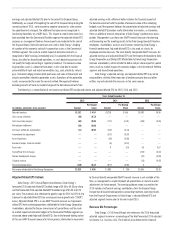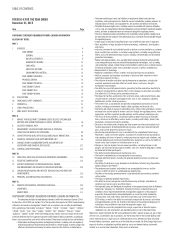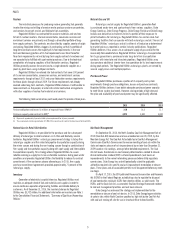Duke Energy 2015 Annual Report Download - page 28
Download and view the complete annual report
Please find page 28 of the 2015 Duke Energy annual report below. You can navigate through the pages in the report by either clicking on the pages listed below, or by using the keyword search tool below to find specific information within the annual report.
PART I
8
Potential Plant Retirements
The Subsidiary Registrants periodically file Integrated Resource Plans
(IRP) with state regulatory commissions. The IRPs provide a view of forecasted
energy needs over a long term (10 to 20 years) and options being considered
to meet those needs. Recent IRPs filed by the Subsidiary Registrants included
planning assumptions to potentially retire certain coal-fired generating
facilities earlier than their current estimated useful lives. These facilities do
not have the requisite emission control equipment, primarily to meet United
States Environmental Protection Agency (EPA) regulations recently approved or
proposed. Duke Energy continues to evaluate the potential need to retire these
coal-fired generating facilities earlier than the current estimated useful lives,
and plans to seek regulatory recovery for amounts that would not be otherwise
recovered when any of these assets are retired. For additional information
related to potential plant retirements see Note 4 to the Consolidated Financial
Statements, “Regulatory Matters.”
On October 23, 2015, the EPA published in the Federal Register the
Clean Power Plan (CPP) rule for regulating carbon dioxide (CO2) emissions from
existing fossil fuel-fired electric generating units (EGUs). The CPP establishes
CO2 emission rates and mass cap goals that apply to fossil fuel-fired generation.
Under the CPP, states are required to develop and submit a final compliance
plan, or an initial plan with an extension request, to the EPA by September 2016,
or no later than September 2018 with an approved extension. These state plans
are subject to EPA approval, with a federal plan applied to states that fail to
submit a plan to the EPA or if a state plan is not approved. Legal challenges to
the CPP have been filed by stakeholders and motions to stay the requirements
of the rule pending the outcome of the litigation have been filed. The U.S.
Supreme Court granted a Motion to Stay in February 2016, effectively blocking
enforcement of the rule until legal challenges are resolved. Final resolution of
these legal challenges could take several years. Compliance with CPP could
cause the industry to replace coal generation with natural gas and renewables,
especially in states that have significant CO2 reduction targets under the rule.
Costs to operate coal-fired generation plants continue to grow due to increasing
environmental compliance requirements, including ash management costs
unrelated to CPP, and this may result in the retirement of coal-fired generation
plants earlier than the current useful lives. Duke Energy continues to evaluate
the need to retire generating facilities and plans to seek regulatory recovery,
where appropriate, for amounts that have not been recovered upon asset
retirements. However, recovery is subject to future regulatory approval, including
the recovery of carrying costs on remaining book values, and therefore cannot
be assured.
Sources of Electricity
Regulated Utilities relies principally on coal, natural gas and nuclear fuel for its generation of electricity. The following table lists sources of electricity and fuel
costs for the three years ended December 31, 2015.
Generation by Source(d)
Cost of Delivered Fuel per Net
Kilowatt-hour Generated (Cents)(d)
2015 2014(e) 2013(e) 2015 2014 2013
Coal(a) 29.0% 33.5% 32.8% 3.24 3.54 3.67
Nuclear(a) 27.0% 26.1% 26.3% 0.65 0.65 0.66
Natural gas and oil(a) 23.1% 19.0% 19.5% 3.74 4.70 4.18
All fuels (cost-based on weighted average)(a) 79.1% 78.6% 78.6% 2.50 2.86 2.79
Hydroelectric and solar(b) 0.8% 0.8% 1.3%
Total generation 79.9% 79.4% 79.9%
Purchased power and net interchange(c) 20.1% 20.6% 20.1%
Total sources of energy 100.0% 100.0% 100.0%
(a) Statistics related to all fuels reflect Regulated Utilities’ ownership interest in jointly owned generation facilities.
(b) Generating figures are net of output required to replenish pumped storage facilities during off-peak periods.
(c) Purchased power includes renewable energy purchases.
(d) Includes the effect of the Joint Dispatch Agreement (JDA).
(e) Amounts for 2014 and 2013 have been adjusted to reflect the inclusion of Duke Energy Ohio auction purchases from PJM and Purchased power and net interchange.
Coal
Regulated Utilities meets its coal demand through a portfolio of long-
term purchase contracts and short-term spot market purchase agreements.
Large amounts of coal are purchased under long-term contracts with mining
operators who mine both underground and at the surface. Regulated Utilities
uses spot market purchases to meet coal requirements not met by long-term
contracts. Expiration dates for its long-term contracts, which have various price
adjustment provisions and market re-openers, range from 2016 to 2017 for
Duke Energy Carolinas, 2016 to 2018 for Duke Energy Progress, 2016 to 2017
for Duke Energy Florida, and 2016 to 2025 for Duke Energy Indiana. Regulated
Utilities expects to renew these contracts or enter into similar contracts with
other suppliers as existing contracts expire, though prices will fluctuate over
time as coal markets change. Coal purchased for the Carolinas is primarily
produced from mines in Central Appalachia, Northern Appalachia and the Illinois
Basin. Coal purchased for Florida is primarily produced from mines in Colorado
and the Illinois Basin. Coal purchased for Indiana is primarily produced in
Indiana and Illinois. Regulated Utilities has an adequate supply of coal under
contract to fuel its projected 2016 operations and a significant portion of supply
to fuel its projected 2017 operations. As a result of lower natural gas prices
and less coal-fired dispatch within the generation fleet, coal inventories may
periodically exceed production requirements and result in higher inventory
levels. In these circumstances, Regulated Utilities has worked with suppliers
to defer contracted deliveries, renegotiate existing contract volumes or has
received regulatory support to adjust generation dispatch to reduce the inventory
levels.
The current average sulfur content of coal purchased by Regulated
Utilities is between 1.5 percent and 2 percent for Duke Energy Carolinas,
between 1.5 percent and 2 percent for Duke Energy Progress, between
1 percent and 2.5 percent for Duke Energy Florida, and between 2 percent and
3 percent for Duke Energy Indiana. Regulated Utilities’ environmental controls,
in combination with the use of sulfur dioxide (SO2) emission allowances,
enable Regulated Utilities to satisfy current SO2 emission limitations for its
existing facilities.
























